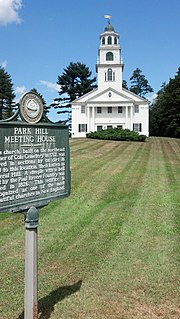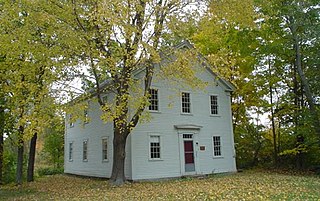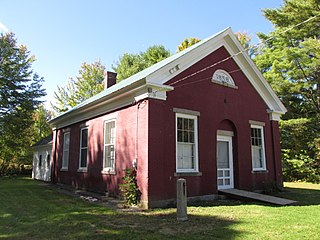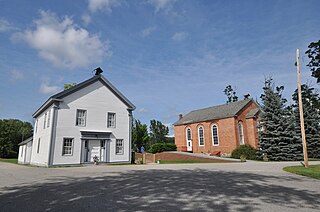
The Universalist Society Meetinghouse is an historic Greek Revival meetinghouse at 3 River Road in Orleans, Massachusetts. Built in 1834, it was the only Universalist church built in Orleans, and is architecturally a well-preserved local example of Greek Revival architecture. The Meeting House is now the home of the Orleans Historical Society and is known as the Meeting House Museum. It was listed on the National Register of Historic Places in 1999.

The Park Hill Meetinghouse is a historic meeting house on Park Hill in Westmoreland, New Hampshire. Built in 1764, and extensively restyled in the early 19th century, it is a fine example of Federal and Greek Revival architecture, influenced by the work of regionally prominent architect Elias Carter. The building was listed on the National Register of Historic Places in 1980. It is now owned by the Westmoreland Park Hill Meetinghouse and Historical Society.

The First Free Will Baptist Church in Meredith is a historic church building at 61 Winona Road in Meredith, New Hampshire, United States. Built about 1802 and remodeled in 1848, it is a good example of a mid-19th century vernacular Greek Revival rural church. It is now a museum called the Pottle Meeting House, managed by the local historical society. The building was listed on the National Register of Historic Places in 1986.

The Sandown Old Meetinghouse is a historic meeting house on Fremont Road in Sandown, New Hampshire. Built in 1773, this two-story timber-frame structure is a virtually unaltered late-Colonial civic and religious structure. It is believed to be unique in the state for its level of preservation, both internal and external. The building, now maintained by a nonprofit organization, was listed on the National Register of Historic Places in 1978, and the New Hampshire State Register of Historic Places in 2011.

The Square Schoolhouse is a historic schoolhouse at the junction of New Hampshire Route 156 and Ledge Hill Road in Nottingham, New Hampshire. Built about 1850, it is one of the best-preserved mid-19th century schoolhouses in southern New Hampshire. It served as a school until 1920, and is now a local museum. It was listed on the National Register of Historic Places in 1980. It is named not for its shape, but for its location in Nottingham Square.

The Indian Stream Schoolhouse is a historic school building on Tabor Road in Pittsburg, New Hampshire. Built in 1897, it is one of the town's few surviving 19th-century district schoolhouses. It was listed on the U.S. National Register of Historic Places in 2011, and the New Hampshire State Register of Historic Places in 2007. It presently serves as a local history museum, open for tours by appointment.

The Tucker Mountain Schoolhouse is a historic one-room schoolhouse on Tucker Mountain Road in Andover, New Hampshire. The small wood-frame building was built in 1837, and served as a schoolhouse until 1893, when it was closed due to declining enrollments. The building was listed on the National Register of Historic Places in 2005. It is now owned by the Andover Historical Society, and is occasionally open to the public in the summer.

The District No. 2 Schoolhouse, also known as the Little Red Schoolhouse, is a historic one-room schoolhouse at 2851 Wakefield Road in Wakefield, New Hampshire. Built in 1858–59, it was at the time one of the finest district schoolhouses in rural New Hampshire. It was used as a school until 1941, and now houses the museum of the local historical society. The building was listed on the National Register of Historic Places in 1980.

The Flint Estate is a historic summer estate in Antrim, New Hampshire. The estate consists of a collection of five buildings, some of early-to-mid 19th century origin, either brought together or built by Wyman Kneeland Flint beginning in 1913. They represent the surviving elements of the village of North Antrim, much of which was destroyed by fire in 1888. Most of the estate is now owned by the Maharishi Academy of Total Knowledge.

The Madison School, District No. 1 is a historic one-room district schoolhouse, located on the grounds of the Madison Elementary School on New Hampshire Route 113 in Madison, New Hampshire. The school was built in 1835, and continues to exhibit Greek Revival characteristics despite alterations in 1873 and 1951. It was used as a school until 1950, has hosted town meetings, and has served as the local library. It is presently home to the local historical society. The building was listed on the National Register of Historic Places in 1980, and the New Hampshire State Register of Historic Places in 2006.

The North Sandwich Meeting House is a historic Quaker meeting house at the northwest junction of Quaker-Whiteface Road and Brown Hill Road in Sandwich, New Hampshire. Built in 1881, it is the best-preserved 19th-century Quaker meeting house in the county. The building was listed on the National Register of Historic Places in 1986, at which time it was the only active Quaker meeting house in Carroll County.

The North Weare Schoolhouse is a historic school building on Old Concord State Road in northern Weare, New Hampshire. Built about 1856, it is a stylistically distinctive vernacular mixing of Federal, Greek Revival, and Italianate styling. It is the most architecturally distinctive of Weare's surviving 19th-century schoolhouses. It was used as a public school until 1952, and then served as a grange hall until the 1980s. The building was listed on the National Register of Historic Places in 1995.

The Wakefield Village Historic District encompasses the historic village center of Wakefield, New Hampshire. It is centered at the junction of New Hampshire Route 153 and Mountain Laurel Road, which was historically the major north–south route in Carroll County. The district consists mainly of residential properties dating from the 18th to early 20th centuries, and also includes the 1836 town hall, public library¸ Grange Hall, and a one-room schoolhouse that now houses the local historical society. The district was listed on the National Register of Historic Places in 1984.

The Cote House is a historic house on Goshen Center Road in Goshen, New Hampshire. Built about 1846 as a schoolhouse, it is one of a cluster of plank-frame houses in Goshen. The building served as a school until 1926, and is now a private residence. The house was listed on the National Register of Historic Places in 1985.

The Kensington Town House is the town hall of Kensington, New Hampshire. Located at 95 Amesbury Road, the single-story wood-frame building was erected in 1846, and has been its only purpose-built municipal hall. It is a good local example of civic Greek Revival architecture, and its hall has historically hosted town meetings and social functions. The building was listed on the National Register of Historic Places in 2013.

The Washington Common Historic District encompasses a cluster of three civic buildings and the town common in the center of Washington, New Hampshire. The town common began as a 2-acre (0.81 ha) parcel acquired in 1787, and the current town hall followed in 1789. It is a two-story wood-frame building which originally served as both a civic and religious meeting house. The adjacent Gothic Revival Congregational Church was built in 1840. The third structure is the Schoolhouse, a 2+1⁄2-story two-room school built in 1883. The district was listed on the National Register of Historic Places in 1986.

Bristol Town Hall, at 45 Summer Street, is the town hall of Bristol, New Hampshire. It is a single story Greek Revival structure, built in 1849, and was the town's first purpose-built town hall. It continues to serve as a municipal meeting and polling place, although town offices are now in a modern building on Lake Street. The building was listed on the National Register of Historic Places in 2015.

The School House and Town Hall is a historic municipal building on Schoolhouse Road, just west of United States Route 7 in the center of Leicester, Vermont. Built about 1858, it is a fine example of late Greek Revival architecture, and is the town's best-preserved district schoolhouse. Its upper floor has served as the town hall since its construction. It was listed on the National Register of Historic Places in 1988.

The Langdon Meeting House is a historic meeting house and former church at 5 Walker Hill Road in Langdon, New Hampshire. Completed in 1803 as a combination town hall and church, it is now a multifunction space owned by the town, and is claimed by the town to hold the record for consecutive town meetings held in the same space. The building was listed on the National Register of Historic Places in 2020, and the New Hampshire State Register of Historic Places in 2012.























